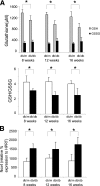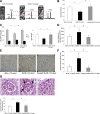Noninvasive in vivo imaging of diabetes-induced renal oxidative stress and response to therapy using hyperpolarized 13C dehydroascorbate magnetic resonance
- PMID: 25187363
- PMCID: PMC4303960
- DOI: 10.2337/db13-1829
Noninvasive in vivo imaging of diabetes-induced renal oxidative stress and response to therapy using hyperpolarized 13C dehydroascorbate magnetic resonance
Abstract
Oxidative stress has been proposed to be a unifying cause for diabetic nephropathy and a target for novel therapies. Here we apply a new endogenous reduction-oxidation (redox) sensor, hyperpolarized (HP) (13)C dehydroascorbate (DHA), in conjunction with MRI to noninvasively interrogate the renal redox capacity in a mouse diabetes model. The diabetic mice demonstrate an early decrease in renal redox capacity, as shown by the lower in vivo HP (13)C DHA reduction to the antioxidant vitamin C (VitC), prior to histological evidence of nephropathy. This correlates with lower tissue reduced glutathione (GSH) concentration and higher NADPH oxidase 4 (Nox4) expression, consistent with increased superoxide generation and oxidative stress. ACE inhibition restores the HP (13)C DHA reduction to VitC with concomitant normalization of GSH concentration and Nox4 expression in diabetic mice. HP (13)C DHA enables rapid in vivo assessment of altered redox capacity in diabetic renal injury and after successful treatment.
© 2015 by the American Diabetes Association. Readers may use this article as long as the work is properly cited, the use is educational and not for profit, and the work is not altered.
Figures





References
-
- American Diabetes Association. Statistics about diabetes: data from the National Diabetes Statistics Report, 2014 (released June 10, 2014) [article online], 2014. Available from http://www.diabetes.org/diabetes-basics/diabetes-statistics/. Accessed 10 June 2014
-
- Caramori ML, Mauer M. Diabetes and nephropathy. Curr Opin Nephrol Hypertens 2003;12:273–282 - PubMed
-
- Rösen P, Nawroth PP, King G, Möller W, Tritschler HJ, Packer L. The role of oxidative stress in the onset and progression of diabetes and its complications: a summary of a Congress Series sponsored by UNESCO-MCBN, the American Diabetes Association and the German Diabetes Society. Diabetes Metab Res Rev 2001;17:189–212 - PubMed
-
- Nishikawa T, Edelstein D, Du XL, et al. . Normalizing mitochondrial superoxide production blocks three pathways of hyperglycaemic damage. Nature 2000;404:787–790 - PubMed
-
- Forbes JM, Coughlan MT, Cooper ME. Oxidative stress as a major culprit in kidney disease in diabetes. Diabetes 2008;57:1446–1454 - PubMed
Publication types
MeSH terms
Substances
Grants and funding
LinkOut - more resources
Full Text Sources
Other Literature Sources
Medical
Molecular Biology Databases
Research Materials
Miscellaneous

